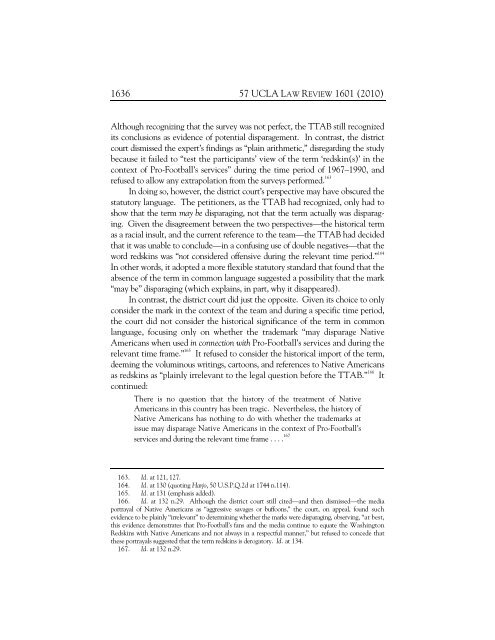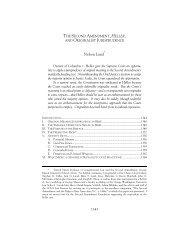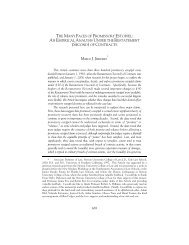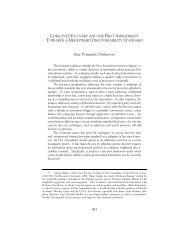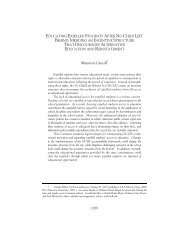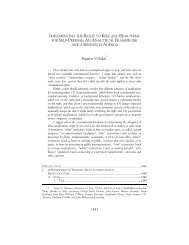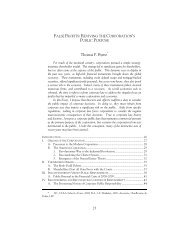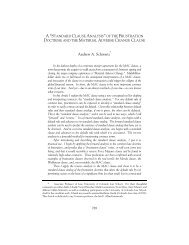Sonia K. Katyal - UCLA Law Review
Sonia K. Katyal - UCLA Law Review
Sonia K. Katyal - UCLA Law Review
You also want an ePaper? Increase the reach of your titles
YUMPU automatically turns print PDFs into web optimized ePapers that Google loves.
1636 57 <strong>UCLA</strong> LAW REVIEW 1601 (2010)<br />
Although recognizing that the survey was not perfect, the TTAB still recognized<br />
its conclusions as evidence of potential disparagement. In contrast, the district<br />
court dismissed the expert’s findings as “plain arithmetic,” disregarding the study<br />
because it failed to “test the participants’ view of the term ‘redskin(s)’ in the<br />
context of Pro-Football’s services” during the time period of 1967–1990, and<br />
refused to allow any extrapolation from the surveys performed. 163<br />
In doing so, however, the district court’s perspective may have obscured the<br />
statutory language. The petitioners, as the TTAB had recognized, only had to<br />
show that the term may be disparaging, not that the term actually was disparaging.<br />
Given the disagreement between the two perspectives—the historical term<br />
as a racial insult, and the current reference to the team—the TTAB had decided<br />
that it was unable to conclude—in a confusing use of double negatives—that the<br />
word redskins was “not considered offensive during the relevant time period.” 164<br />
In other words, it adopted a more flexible statutory standard that found that the<br />
absence of the term in common language suggested a possibility that the mark<br />
“may be” disparaging (which explains, in part, why it disappeared).<br />
In contrast, the district court did just the opposite. Given its choice to only<br />
consider the mark in the context of the team and during a specific time period,<br />
the court did not consider the historical significance of the term in common<br />
language, focusing only on whether the trademark “may disparage Native<br />
Americans when used in connection with Pro-Football’s services and during the<br />
relevant time frame.” 165<br />
It refused to consider the historical import of the term,<br />
deeming the voluminous writings, cartoons, and references to Native Americans<br />
as redskins as “plainly irrelevant to the legal question before the TTAB.” 166<br />
It<br />
continued:<br />
There is no question that the history of the treatment of Native<br />
Americans in this country has been tragic. Nevertheless, the history of<br />
Native Americans has nothing to do with whether the trademarks at<br />
issue may disparage Native Americans in the context of Pro-Football’s<br />
services and during the relevant time frame . . . . 167<br />
163. Id. at 121, 127.<br />
164. Id. at 130 (quoting Harjo, 50 U.S.P.Q.2d at 1744 n.114).<br />
165. Id. at 131 (emphasis added).<br />
166. Id. at 132 n.29. Although the district court still cited—and then dismissed—the media<br />
portrayal of Native Americans as “aggressive savages or buffoons,” the court, on appeal, found such<br />
evidence to be plainly “irrelevant” to determining whether the marks were disparaging, observing, “at best,<br />
this evidence demonstrates that Pro-Football’s fans and the media continue to equate the Washington<br />
Redskins with Native Americans and not always in a respectful manner,” but refused to concede that<br />
these portrayals suggested that the term redskins is derogatory. Id. at 134.<br />
167. Id. at 132 n.29.


